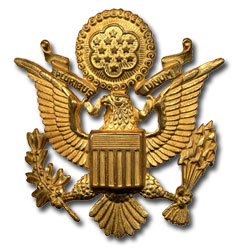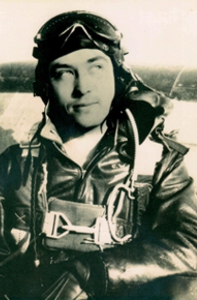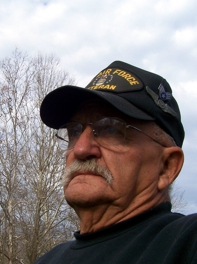1st Lt. Charles William Moore, 23, was a fighter pilot flying the P-51 Mustang and P-47 Thunderbolt with the famous 354th Pioneer Mustang Fighter Group, a unit of the Nineteenth Tactical Air Command. He was killed in action over Germany on April 4, 1945. He is buried in South Perinton Cemetery, Monroe County, in Fairport, New York.
Charles was born on January 12, 1922 to Mr. and Mrs. George Moore of Fairport, New York. He graduated from Fairport High School and before the war was employed as a painter. He enlisted in the U.S. Army Air Corp on January 1941 in Rochester, New York. He attended the school for Air Corps mechanics at Chanute Field, Illinois, and graduated in September 1941, He then entered pilot training and received his commission and wings in May 1943.
2nd Lt. Moore served as advanced flying instructor at Jackson Army Air Base at Jackson, Mississippi. In August 1944 he received orders for overseas combat duty. His wife, Hazel and daughter, Cynthia Ann would remain in Jackson.
He arrived in the England in late November and on December 4th, Lt. Charles W. Moore was among eight replacement pilots assigned to the 355th Fighter Squadron, known as the "Pugnacious Pups".
At the time of Moore’s arrival at Rosières-en-Haye (A-98) the outfit was transitioning into the P-47 Thunderbolt. Moore and the other replacement pilots were trained in P-47s back in the states and were flying combat missions within a few days of their arrival. Equipped with the P-47 Thunderbolt the 354th was now supporting the Third Army's advance through France into Germany.
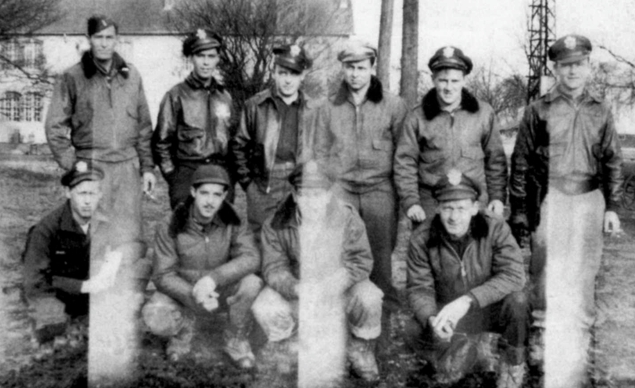
Top row (left to right): Robert Curlee, Ralph Tyler, Charles Moore, Raymond Bain, Bill Koerner and Kenneth Gorman. Bottom row: Chuck Tighe, Bob Foye, John Hayes, and George New. By VE Day Tyler, Moore and New would be killed in action. Bain and Gorman would be prisoners of war.
On December 5th the squadron flew its first mission in P-47s, they were sent to dive-bomb an ammunition dump east of Koblenz, Germany. The target couldn't be reached because of bad weather and they were diverted to attack a marshalling yard, destroying ten locomotives.
When the Germans launched operation HERBSTNEBEL (Autumn Fog) on December 16th, they penetrated 30 miles into Belgium and Luxembourg, USAAF tactical air units were to play a vital role in this campaign that would come to be known as the Battle of the Bulge. What was most disturbing to the group was that Rosiere-en-Haye field was only 50 miles away from the German breakthrough.
In one action during the Battle of the Bulge, Lt. Moore bombed and strafed six German tiger tanks opposing the advance of Third Army troops, Moore, destroyed one and dispersed the rest. The action took place north of Bastogne.
"One 500 pounder bounced right into a tiger tank," he reported. “It blew apart as though each rivet were made of thread. What was left started to burn. The remaining tanks rumbled for cover into the woods."
The weather severely hampered all tactical air support to frontline troops however the use of radar and pilots embedded with front line troops made for an effective combination as evident on a "Fox Hunt" mission carried out on December 13th. Lt. Moore was part of a four-ship flight led by Squadron CO Major Talbot. Frontline radar directed them to a target near Meckel. At the direction of radar control thru overcast from 10,000 ft. flying straight and level they bombed and destroyed an enemy truck convoy.
During two months of combat Lt. Moore completed 44 missions over enemy territory, with a total of 109 combat hours of over 40 sorties. Lt. Moore has dive bombed and strafed enemy airfields, railroad yards, tanks and other military installations. Earning triple honors, the Air Medal and the first and second Bronze Leaf Clusters, were awarded, for "meritorious achievement while participating in combat flights." Major General O.P. Weyland, Nineteenth Tactical Air Command, made the presentation.
On February 4, 1945, the 354th received word that they would be getting its Mustangs back. According to the squadron historian; "A-98 was treated to a kind of buzz job it had never known before. Several gleaming Mustangs circled the field before making a series of low-passes, flying in flights abreast over squadrons areas and down the runways as though under a 50-foot ceiling."
The squadron flew their P-47s one last time on February 15th when they carried out dive-bombing missions against ground targets in cooperation with VIII Corps near the Prum area. Two days later they flew their first mission in Mustangs, a fighter sweep to Limburg.
The group would continue supporting ground troops, conduct patrols and fighter sweeps, armed reconnaissance and occasional escort.
April 4, 1945, east of Frankfurt, Germany, Lt. Charles Moore was one of twelve Mustangs returning from a mission when they were fired upon by enemy anti-aircraft guns. In a statement filed by 1st Lt. Robert E. Roberson, he explains what happened:
"We were letting down though the over cast while returning from an afternoon mission at 1710 on the 4th of April and on breaking out at 5000 feet, Red Flight was fired at by at least ten anti-aircraft guns. I was unable to determine the caliber. Red Flight pulled back up the overcast where shells must have been bursting. I was in White Flight which was a little slower going back up. Just before we reached the clouds I saw a plane come out of the clouds on fire on a vertical dive. The plane hit the ground and exploded. I believe this could have been Lt. Moore as he was in Red Flight. It is very possible the pilot could have bailed out although I saw no parachute."
Lt. Moore's Mustang was mortally hit. The squadron’s after mission report listed him as missing in action but that status later changed to killed in action.
2nd Lt. Charles W. Moore received his promotion to 1st Lieutenant on April 15, 1945, posthumously. Among his Air Medal with Bronze Leaf Clusters he was also awarded the Purple Heart and Presidential Unit Citation.
Alvin Moore was proud that his brother Charles was a Mustang fighter pilot. Alvin, himself was an USAAF instructor pilot training Air Corp Cadets in the AT-6 Texan and Beechcraft's twin-engine AT-11 while stationed at Keesler Air Base at Biloxi, Mississippi during the war.
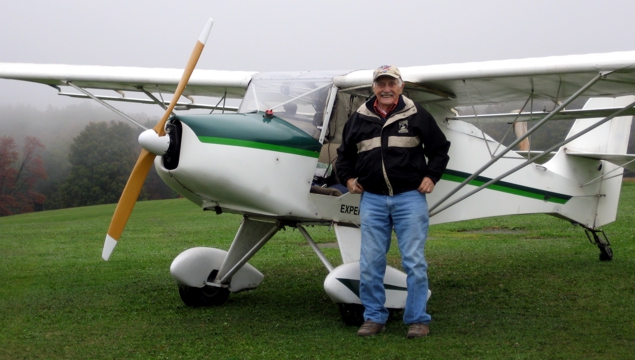
Charles W. Moore's brother Alvin Moore with his 1984 Avid Flyer "A" model Experimental plane at a grass strip airport. (Bond)
In an official government report to the family, they had been informed that he was buried originally in an isolated grave at Pfersdorf, Germany, and later after being identified was re-interred in a military cemetery at St. Avold, located 23 miles east of Metz, France. His remains were brought back to Fairport in 1950.
"After the war Alvin dedicated a lot of time searching for information about his brother, but more or less came to a dead end." said Milton Bond, Alvin's close friend. Sadly Alvin passed away on the 12th of December 2012 of lung cancer, at the age of 87 not ever knowing the facts of that day in the skies over Germany.
Milton was operating a small grass strip airport when he met Alvin. "One day he stopped to see if I had anything for sale. He did in fact buy a plane from me." said Milton. Both Alvin and Milton owned the same type of airplane and began flying together and developed a close brotherly friendship. "We talked many time about his brother Charles, and how proud he was that his brother was a P-51 pilot". Milton a Korean War veteran himself served in the USAF from 1951-55 as a Morse Code Radio Operator. He was determined to continued Alvin's search, "this is the last thing I can do for him and his family and Lt. Charles W. Moore.", says Milton.
This tribute is a result of information provided by Mr. Bond, the Moore family and official unit historical records passed on to 354thpmfg.com by Charles J. “Chuck” Tighe, former 355th Fighter Squadron Pilot.

